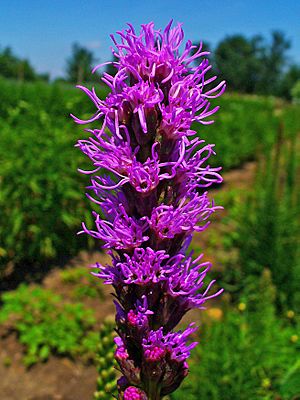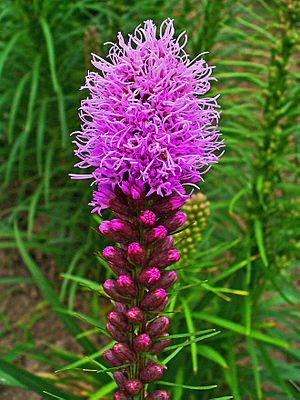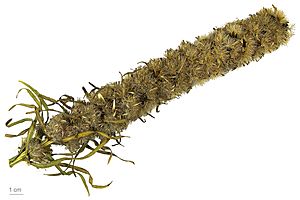Dense blazing star facts for kids
Quick facts for kids Dense blazing star |
|
|---|---|
 |
|
| Scientific classification | |
| Genus: |
Liatris
|
| Species: |
spicata
|
The Dense Blazing Star, also known as Prairie Gay Feather, is a beautiful flowering plant. It's a type of plant that lives for many years, called a perennial. This plant belongs to the sunflower and daisy family, named Asteraceae. You can find it growing naturally in eastern North America, especially in wet prairies and grassy meadows.
These plants are known for their tall, spiky purple flowers. They often look like bottle brushes or feathery plumes. They can grow quite tall, from about 1 to 5 meters (3 to 16 feet) high! Dense Blazing Star grows well in many places, from the Midwest to the East Coast of the United States, and even in parts of eastern and western Canada.
Some common types of Dense Blazing Star grown in gardens include 'Alba' and 'Floristan White'. These types have white flowers on spikes about 45 centimeters (18 inches) tall. 'Callilepsis' has long stems, which are great for cut flowers. 'Floristan Violett' has strong stems and thick, violet flower spikes. 'Kobold' is a smaller type with deep purple flowers.
There is also a natural variation of the plant called Liatris spicata var. resinosa. This type is found in the southern parts of where the plant naturally grows. These plants have fewer flowers on each head, usually only 5 or 6. Their flower heads are also spaced further apart on the stems. These differences are more noticeable when the plants grow in drier or coastal areas.
Contents
Growing Dense Blazing Star
Dense Blazing Star is a popular garden flower in many countries. People love to grow it because of its amazing purple flowers. Some types also have pink or white flowers. These plants usually bloom from July through August or September. The exact time depends on where they are growing.
When grown in gardens, you might hear this plant called by other names. These include button snakewort, Kansas gay feather, or just blazing star.
What the Plant Needs
For the best growth, Dense Blazing Star needs lots of sunshine. It also prefers soil that drains water well. This helps stop the roots from rotting. Even though the plant likes moist soil, it doesn't like very wet soil during the winter. These plants can handle a little bit of shade and even some dry periods. However, they need regular watering during their first year to grow strong roots.
How to Plant It
You can grow Dense Blazing Star in a few ways. You can plant them from corms, which are like small bulbs. You can also start them from seeds. Or, you can buy young plants directly from garden centers or nurseries.
If you want to grow them from seeds, start them in early spring. You can plant the seeds either indoors or outside. It usually takes about 20 to 45 days for the seeds to sprout. Once the leaves appear, if you have many plants close together, you can divide them into larger groups. It's best to space the plants about 30 to 38 centimeters (12 to 15 inches) apart. Giving them enough space helps with sunlight and air flow. This can prevent common plant diseases like stem rot or leaf spots. When you grow from seeds, the flowers usually appear in the second year.
If you are adding things to your soil, these plants like soil with lots of calcium and magnesium. They prefer lower amounts of potassium and phosphorus.
Using it in Your Garden
Dense Blazing Star looks great planted by itself. It also works well as a border plant along paths or garden edges. Because it grows tall and straight, it looks nice next to rounder or wide-leaf plants. In more natural-looking gardens, planting many of them together creates a beautiful display.
The flowers are also wonderful for cutting. You can use them fresh in a vase or dry them. Dried flowers have a lovely vanilla scent.
Role in Nature
Dense Blazing Star is super important for nature. It's excellent at attracting pollinators and other helpful insects. Many different butterflies love these flowers. These include the monarch, tiger swallowtail, painted lady, and red admiral.
The flowers also attract various types of bees, like bumblebees and leaf-cutting bees. Skippers and birds, including hummingbirds, also visit them. Some rare moth caterpillars, like the glorious flower moth and liatris flower moth, eat the flowers and seeds. Another moth, the liatris borer moth, has caterpillars that bore into the plant's stems. Other animals like groundhogs, rabbits, and voles also enjoy eating these plants.
Deer are less likely to eat Dense Blazing Star compared to other plants. So, it's often considered "deer-resistant." But remember, if deer are very hungry, they might eat almost anything!
Historical Uses
Historically, Native American tribes used Dense Blazing Star for various purposes. They used parts of the plant, especially the root, in traditional remedies. For example, the Cherokee people used it to help with pain in the back and limbs. The Menominee tribe used it for what they called a "weak heart." Native Americans also used the plant to help with swelling, stomach pain, and even snake bites.
Today, some people use the plant for a sore throat by gargling a special liquid made from it. It's also sometimes used as a natural insect repellent or added to potpourri for its scent.



